#MSX2
Explore tagged Tumblr posts
Text

3K notes
·
View notes
Text
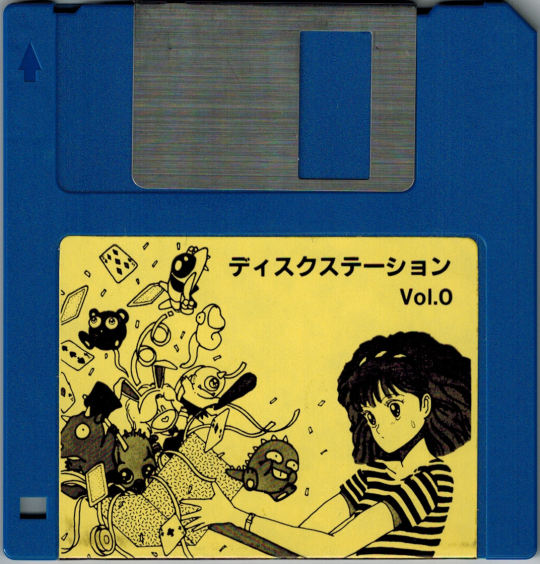
MSX2 コンパイル ディスクステーション#00 創刊準備号 by コンパイル // 1988 [ARCHIVE: @/HD64180]
#retro tech#design#floppy disk#japanese#80s#retro#MSX2#microsoft#illustration#cover art#technology#u
470 notes
·
View notes
Text

mirror selfie
293 notes
·
View notes
Text
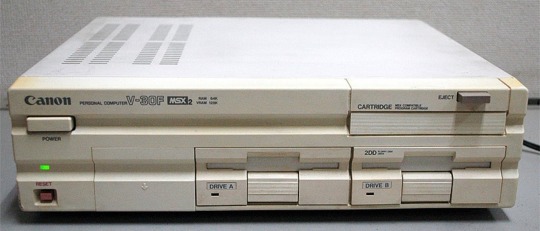
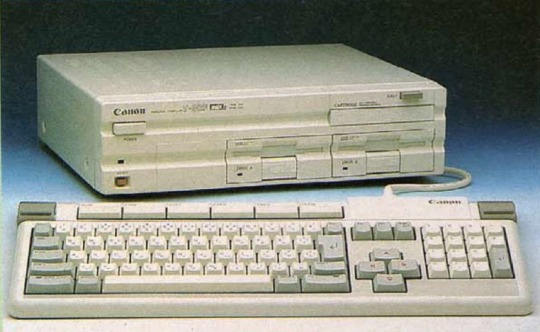
1K notes
·
View notes
Text



📦 metal gear (msx)
375 notes
·
View notes
Text
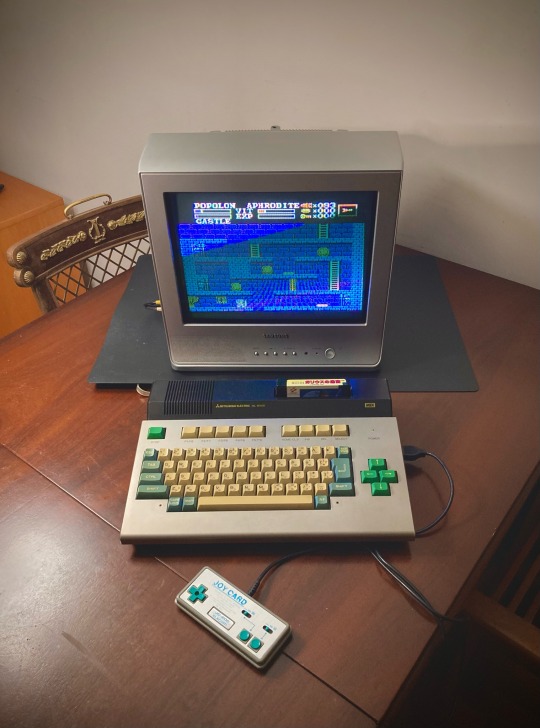
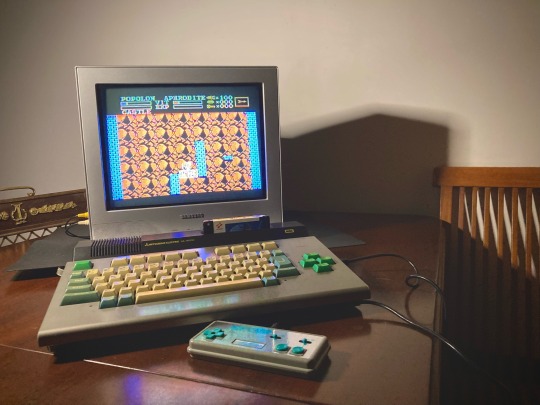
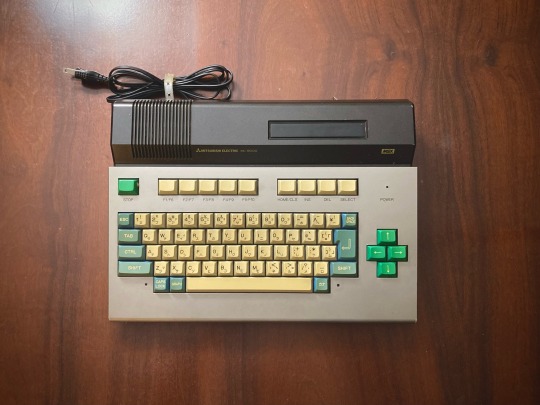
40 years of MSX. Happy birthday!
626 notes
·
View notes
Text

Metal Gear 2: Solid Snake MSX2 1990
#gaming#retro gaming#video games#nostalgia#90s#1990s#aesthetic#pixel art#konami#metal gear#mgs#kojima#hideo kojima#foxhound#msx2#1990#mg2#metal gear 2 solid snake#metal gear 2#fox
162 notes
·
View notes
Text


#oh noooooooooooooooo#gray fox#solid snake#mg2#metal gear 2 solid snake#metal gear#msx2#metal gear solid#allmg2#mg2 solid snake
37 notes
·
View notes
Text








Panasonic FS-A1GT (1992)
The Panasonic FS-A1GT MSX turbo R is the last MSX computer ever produced and follows the latest standard for the MSX line.
Originally, in 1990, Yamaha and ASCII announced the V9978 Video Display Processor, the video chip for the MSX3. It was a very capable video IC, with two different sets of video modes. In bitmap modes, it was capable of up to 768 x 240 resolution (up to 768 x 480 in interlace mode), up to 32,768 colors, superposition, hardware scrolling, and even a hardware cursor for Windows-like operating systems. However, the most impressive feature of these modes was the use of a fast hardware bitblock data mover. The MSX2 video IC was also equipped with a hardware bit mover, but the new one would be 20 times faster!
In pattern mode, it was able to use SNES class features. Multiple layers, 16k patterns, different palettes, 128 sprites, maximum 16 sprites per scanline. So basically an SNES but without mode7. However, something went wrong and the project was cancelled. Probably because of the great interest in marketing MSX machines and the growing interest in game consoles and powerful PC-like computers (mainly for word processing purposes), companies were less enthusiastic about making a new MSX machine. MSX's biggest software supporters defected to Nintendo and other computers/gaming machines. Sony chose to make their own game console.
Instead came the MSX Turbo-R, a supercharged MSX2+. Some people say that ASCII failed to deliver the new VDP in time for the 1990 release, so they only opted for the new CPU (named R800). However, the specifications and pinout of the V9978 were in some data books of the era.
Panasonic was the only company to manufacture and market MSX turbo R computers, and they were only sold in Japan. Several machines were imported to Europe via gray market imports.
The FS-A1ST was the first and was succeeded by the FS-A1GT, which had more RAM and MIDI IN and OUT.
After these two machines, it ended when Panasonic moved to their 3DO game console.
Detailed Specifications
CPU R800 (DAR800-X0G), with 28.63630 MHz external clock and 16-bit ALU.
CPU Z80A 3.579545MHz compatible (included in the MSX-Engine)
256kB of main RAM (can be natively expanded to 512kB internally)
16kB SRAM for backup (used internally)
32kB BASIC/BIOS ROM and 32kB sub-ROM
TC8566AF disk controller
3.5" double sided double density (720kB) disk drive
S1990 MSX Bus-controller
T9769C MSX-ENGINE (also contains Z80A & AY-3-8910)
MSX-JE (a simple Kanji input interface)
Kanji-ROM with approx. 32000 characters
MSX-Music (Yamaha YM-2413 OPLL)
DAC to PCM 8-bit sample rate up to 16kHz
Internal microphone for the PCM unit
More info: https://www.msx.org/wiki/Panasonic_FS-A1ST
#msx#msx2#old tech#panasonic#vintage computer#computer#8bit#z80#industrial design#retrogaming#retro gaming#hardware#electronics#retrocomputing#retro computing#retro tech#retro games#japan#japan only#japan computer#90s
28 notes
·
View notes
Text


Sony HB-F900. From MSX Magazine, Nov. 1986.
34 notes
·
View notes
Text
youtube
Blue Demon Story
A Madou Monogatari/Sorcery Saga side-story.
Follows up directly from Madou Monogatari 1 in MSX2.
#Blue Demon Story#madou monogatari 1-2-3#madou monogatari#sorcery saga#mamono#123#1-2-3#arle nadja#arle#msx#msx2#puyo puyo#puyo#momomo#ghost#suketoudara#vampire#nohoho#wizard#zombie#sukiyapodes#sasori man#Youtube
36 notes
·
View notes
Text

MSX2
#@GGEAR_TARO#MSX2#PC#Sony#hardware#tech#design#retro gaming#MSX2 computer#video games#vintage#retro#80s#1980s
328 notes
·
View notes
Text

'Higemaru Makaijima: Nanatsu no Shima Daibōken'
[MSX2] [JAPAN] [MAGAZINE] [1987]
"Higemaru Makaijima: Nanatsu no Shima Daibōken, is an action game developed by Capcom. It is the sequel to Pirate Ship Higemaru released for the Family Computer and the MSX2. Higemaru Makaijima's April 1987 release also gives Higemaru the distinction of being the first Capcom game to receive a sequel. The game is perhaps most famous, however, for having a level designed entirely as an homage to another Capcom title, Ghosts 'n Goblins. Higemaru Makaijima: Nanatsu no Shima Daibōken would later receive a spiritual sequel in the form of Goof Troop for the SNES." ~Wikipedia
Source: Beep, October 1987 || Internet Archive; taihen
#gaming#advertising#higemaru makaijima: nanatsu no shima daiboken#msx2#fantasy#platformers#action#puzzle#compile#capcom#computer games#japan#1987
11 notes
·
View notes
Text

Crossroads. an experiment with a bit of a cartoonier style, the bright colours of the MSX 2 palette seemed suited for it... She might take up a bit too much memory for a real MSX...
264 notes
·
View notes
Text
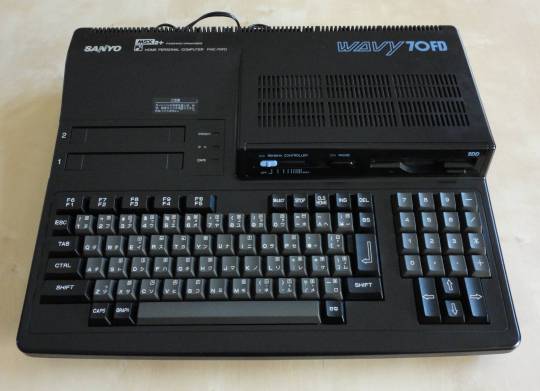
#i want to go back#retro#hardware#retro tech#sanyo#msx2#wavy 70FD#japanese computers#vintage computing
664 notes
·
View notes
